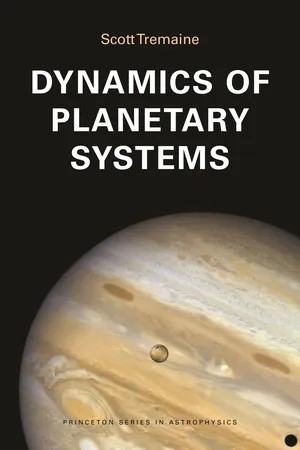
- 640 pages
- English
- PDF
- Available on iOS & Android
Dynamics of Planetary Systems
About this book
An introduction to celestial mechanics for advanced undergraduates, graduate students, and researchers new to the field
Celestial mechanics—the study of the movement of planets, satellites, and smaller bodies such as comets—is one of the oldest subjects in the physical sciences. Since the mid-twentieth century, the field has experienced a renaissance due to advances in space flight, digital computing, numerical mathematics, nonlinear dynamics, and chaos theory, and the discovery of exoplanets. This modern, authoritative introduction to planetary system dynamics reflects these recent developments and discoveries and is suitable for advanced undergraduate and graduate students as well as researchers. The book treats both traditional subjects, such as the two-body and three-body problems, lunar theory, and Hamiltonian perturbation theory, as well as a diverse range of other topics, including chaos in the solar system, comet dynamics, extrasolar planets, planetesimal dynamics, resonances, tidal friction and disruption, and more. The book provides readers with all the core concepts, tools, and methods needed to conduct research in the subject.
- Provides an authoritative introduction that reflects recent advances in the field
- Topics treated include Andoyer variables, co-orbital satellites and quasi-satellites, Hill's problem, the Milankovich equations, Colombo's top and Cassini states, the Yarkovsky and YORP effects, orbit determination for extrasolar planets, and more
- More than 100 end-of-book problems elaborate on concepts not fully covered in the main text
- Appendixes summarize the necessary background material
- Suitable for advanced undergraduates and graduate students; some knowledge of Hamiltonian mechanics and methods of mathematical physics (vectors, matrices, special functions, etc.) required
- Solutions manual available on request for instructors who adopt the book for a course
Frequently asked questions
- Essential is ideal for learners and professionals who enjoy exploring a wide range of subjects. Access the Essential Library with 800,000+ trusted titles and best-sellers across business, personal growth, and the humanities. Includes unlimited reading time and Standard Read Aloud voice.
- Complete: Perfect for advanced learners and researchers needing full, unrestricted access. Unlock 1.4M+ books across hundreds of subjects, including academic and specialized titles. The Complete Plan also includes advanced features like Premium Read Aloud and Research Assistant.
Please note we cannot support devices running on iOS 13 and Android 7 or earlier. Learn more about using the app.
Information
Table of contents
- Cover
- Contents
- Preface
- 1. The two-body problem
- 2. Numerical orbit integration
- 3. The three-body problem
- 4. The N-body problem
- 5. Secular dynamics
- 6. Resonances
- 7. Planetary spins
- 8. Tides
- 9. Planet-crossing orbits
- Appendix A. Physical, astronomical and solar-system constants
- Appendix B. Mathematical background
- Appendix C. Special functions
- Appendix D. Lagrangian and Hamiltonian dynamics
- Appendix E. Hill and Delaunay variables
- Appendix F. The standard map
- Appendix G. Hill stability
- Appendix H. The Yarkovsky effect
- Appendix I. Tidal response of rigid bodies
- Appendix J. Relativistic effects
- Problems
- References
- Index